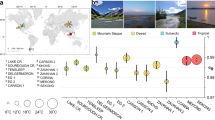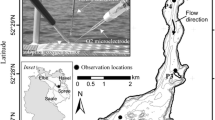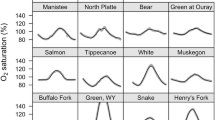Abstract
Quantifying ecosystem respiration remains challenging in aquatic ecosystems. Most investigators assume that nighttime and daytime respiration are equal. Recent studies suggest measuring dissolved oxygen isotopes during periods with and without photosynthesis can account for variations in daytime and nighttime respiration. These models are extremely sensitive to the oxygen isotopic fractionation factor (α) value used for respiration, yet almost nothing is known about the variability of α and factors driving that variability. We quantified how α varies with temperature and flow velocity using field measurements, laboratory experiments, and a modeling approach. We measured α in the field using sealed recirculating chambers in 16 rivers from different biomes (temperate, tropical, and sub-arctic) to assess a range of possible α values. The α values were widely variable, and variation was higher among sites in the same biome or ecoregion (e.g. 0.9780 ± 0.005 to 0.9898 ± 0.002 among six desert sites) than across different biomes. Our data revealed that both temperature, flow, and biofilm characteristics produced variations in α, with temperature decreasing and flow increasing it, until leveling off at high flow velocities. Biological and physical processes occurring in the diffusion boundary layer produced variations in α. Our results highlight that environmental conditions produce variable α values, the need for site-specific α measurements, and practical implications for consideration when measuring α in the field. More generally we illustrate an array of factors that can influence isotopic fractionation associated with metabolic activity of biologically active layers that could be important in any diffusion-limited environment.






Similar content being viewed by others
References
Al-Shemmeri Tarik (2012) Engineering fluid mechanics. Bookboon, London
Battin TJ, Besemer K, Bengtsson MM, Romaní AM, Packmann AI (2016) The ecology and biogeochemistry of stream biofilms. Nat Rev Microbiol 14(4):251–263
De Podesta M (2002) Understanding the properties of matter. CRC Press, Boca Raton
Dodds WK (1989) Photosynthesis of two morphologies of nostoc parmelioides (cyanobacteria) as related to current velocities and diffusion patterns. J Phycol 25(2):258–262
Dodds WK, Biggs BJF (2002) Water velocity attenuation by stream periphyton and macrophytes in relation to growth form and architecture. J N Am Benthol Soc 21(1):2–15
Dodds WK, Collins SM, Hamilton SK, Tank JL, Johnson S, Webster JR, Simon KS, Whiles MR, Rantala HM, McDowell WH, Peterson SD, Riis T, Crenshaw CL, Thomas SA, Kristensen PB, Cheever BM, Flecker AS, Griffiths NA, Crowl T, Rosi-Marshall EJ, El-Sabaawi R, Martí E (2014) You are not always what we think you eat: selective assimilation across multiple whole-stream isotopic tracer studies. Ecology 95(10):2757–2767
Dodds WK, Bruckerhoff L, Batzer D, Schechner A, Pennock C, Renner E, Tromboni F, Bigham K, Grieger S (2019) The freshwater biome gradient framework: predicting macroscale properties based on latitude, altitude, and precipitation. Ecosphere 10:e02786
Finlay JC, Power ME, Cabana G (1999) Effects of water velocity on algal carbon isotope ratios: implications for river food web studies. Limnol Oceanogr 44(5):1198–1203
Grace MR, Giling DP, Hladyz S, Caron V, Thompson RM, Mac Nally R (2015) Fast processing of diel oxygen curves: estimating stream metabolism with BASE (BAyesian Single-station Estimation). Limnol Oceanogr Methods 13(3):e1001
Hotchkiss ER, Hall RO Jr (2014) High rates of daytime respiration in three streams: use of d 18 OO2 and O2 to model diel ecosystem metabolism. Limnol Oceanogr 59(3):798–810
Kafoussias NG, Williams EW (1995) Thermal-diffusion and diffusion-thermo effects on mixed free-forced convective and mass transfer boundary layer flow with temperature dependent viscosity. Int J Eng Sci 33:1369–1384
LaBarbera M, Vogel S (1976) An inexpensive thermistor flowmeter for aquatic biology1. Limnol Oceanogr 21(5):750–756
Lane GA, Dole M (1956) Fractionation of oxygen isotopes during respiration. Science 123(3197):574–576
Mader M, Schmidt C, van Geldern R, Barth JAC (2017) Dissolved oxygen in water and its stable isotope effects: a review. Chem Geol 473:10–12
Raven JA, Beardall J (2005) Respiration in aquatic photolithotrophs. In: del Giorgio PA, Williams PJB (eds) Respiration in aquatic ecosystems. Oxford Univ. Press, Oxford, pp 36–46
Reid RC, Prausnitz JM, Sherwood TK (1977) The properties of gases and liquids, 3rd edn. McGraw-Hill, New York, pp 629–665
Rosseel Y (2012) lavaan: an R package for structural equation modeling. J Stat Soft 48:1–36
Rüegg J, Brant JD, Larson DM, Trentman MT, Dodds WK (2015) A portable, modular, self-contained recirculating chamber to measure benthic processes under controlled water velocity. Freshw Sci 34(3):831–844
Schleser GH (1979) Oxygen isotope fractionation during respiration for different temperatures of T. utilis and E. coli K12. Radiat Environ Biophys 17(1):85–93
Song C, Dodds WK, Rüegg J et al (2018) Continental-scale decrease in net primary productivity in streams due to climate warming. Nat Geosci 11:415–420. https://doi.org/10.1038/s41561-018-0125-5
Tobias CR, Böhlke JK, Harvey JW (2007) The oxygen-18 isotope approach for measuring aquatic metabolism in high-productivity waters. Limnol Oceanogr 52(4):1439–1453
Vogel S (1996) Life in moving fluids: the physical biology of flow. Princeton Univ Press, Princeton
Wang X, Depew D, Schiff S, Smith REH (2008) Photosynthesis, respiration, and stable isotopes of oxygen in a large oligotrophic lake (Lake Erie, USA–Canada). Can J Fish Aquat Sci 65(11):2320–2330
Wilke CR, Chang P (1955) Correlation of diffusion coefficients in dilute solutions. AIChE J 1(2):264–270
Acknowledgements
We thank Bonnie Trejo, Khaliun Sanchir, Loren Secor, Liana Prudencio, Christie Carey, Thomas Harmon, Curtis Gray, Brian Reid, and Lizzy Sisson for their help in the field.
Funding
Flavia Tromboni, Walter K. Dodds, Sudeep Chandra and Anne Schechner were funded by NSF Macrosystems, Award 1442562.
Author information
Authors and Affiliations
Corresponding author
Additional information
Publisher's Note
Springer Nature remains neutral with regard to jurisdictional claims in published maps and institutional affiliations.
Responsible Editor: Sujay Kaushal.
Rights and permissions
About this article
Cite this article
Tromboni, F., Dodds, W.K., Chandra, S. et al. Respiration in rivers fractionates stable isotopes of dissolved oxygen; a global investigation on the influences of temperature and flow. Biogeochemistry 147, 199–210 (2020). https://doi.org/10.1007/s10533-020-00636-z
Received:
Accepted:
Published:
Issue Date:
DOI: https://doi.org/10.1007/s10533-020-00636-z




